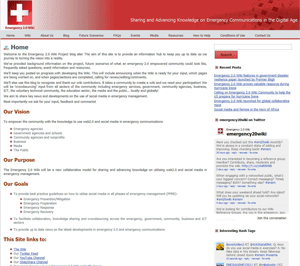Social media - break in case of emergency

The summer of 2010/11 saw a rash of natural disasters across Australia. The floods and cyclones that devastated the lives and property of so many have left lasting impacts on not only the landscape and our memories but also on the expectations of government, writes David Schulz.
The information needs in emergency situations has done much to validate an emerging use of Web 2.0 tools including social media. In response many government agencies are establishing, formalising or expanding a social media presence. This is inevitable and in many ways admirable.
However, engaging with social media without a clear plan and understanding how this fits within a broader engagement strategy is not without risk.
Effective emergency management requires a rapid flow of accurate information to allow people to plan and respond to events that are unfolding quickly. What became clear last summer was that Twitter and Facebook were satisfying the information needs of many people more effectively than the official communication channels of Council and State Government emergency management teams.
Advice of warnings and evacuations were reaching the public ahead of the official notifications. People seeking information from agencies’ websites and formal channels of information were poorly served. Council reputations in particular suffered at this perceived failure to communicate with the speed their communities expected.
On the other hand, those agencies that had an established social media presence were able to rapidly and authoritatively respond and reaped massive reputation gains. The anti-authoritarian streak that runs deep in Australian culture makes it all the more extraordinary that hundreds of thousands of people ‘Like” the Queensland Police Facebook page!
In response we are seeing many agencies plunging into social media and establishing presences in a range of these new media channels. The problem with many of these initiatives is that there is no clear reason driving the push to social media.
 At best the social media initiative, in isolation, doesn’t build genuine engagement or a sense of community and withers on the vine. At worst, a social media presence that is not part of a broader, well conceived community engagement program jeopardises the organisation’s reputation and credibility and exposes it to the risks that arise from poor information management.
At best the social media initiative, in isolation, doesn’t build genuine engagement or a sense of community and withers on the vine. At worst, a social media presence that is not part of a broader, well conceived community engagement program jeopardises the organisation’s reputation and credibility and exposes it to the risks that arise from poor information management.
If messages in social media channels are not consistent with each other and traditional communications, the organisation’s credibility will suffer. If responses received via social media are not acknowledged and actioned, people will be frustrated, feel rejected and the reputation of the organisation will be damaged.
If your organisation cannot demonstrate what information was provided over social media it risks not being able to defend itself from claims of loss arising from reliance on information that was allegedly provided, or not provided through those channels.
The experience of the Gov 2.0 Taskforce and their approach to information governance is instructive. The Taskforce sought to ‘own’ the environment in which collaboration and discussion took place. Sure they had a Facebook page and a Twitter stream but those channels were used purely as a means to publicise.
Information already held in other locations was pushed to these channels. When people sought to respond, they were directed to sites they managed directly. This is important from a management and information governance perspective.
Nothing novel was placed on social media. That made these channels records management neutral. Incoming communication was directed to their own online engagement platforms. These were selected to provide the moderation and structure that allowed meaningful use of this information and reduced the risk of non-constructive discussion. These tools were also selected based on the ease in which information could be extracted and folded into existing record management processes and systems.
Government agencies need a holistic engagement program that recognises new expectations in their communities. Social media is useful as the outgoing communications channel for the engagement program. The information pushed to social media will ideally originate from an online engagement system that provides the destination for people when they respond.
An online engagement system will allow you to readily get a better measure of community sentiment across a more representative sample of the community at much less cost and effort than a public meeting or traditional surveys. A robust online engagement platform will also give your agency a holistic view of all the responses from any individual so you can over time build a complete picture of each person and the issues that are important to them.
The lessons from the summer of 2010/11 are clear. Our communities expect more agile response and rapid communication from all levels of government, particularly in times of crisis. Social media is a useful tool in responding to this expectation. Social media must form part of a broader engagement program that utilises the power of online engagement and minimises risk, effort and cost.
David Schulz is Industry Solutions Manager at Objective Corporation
